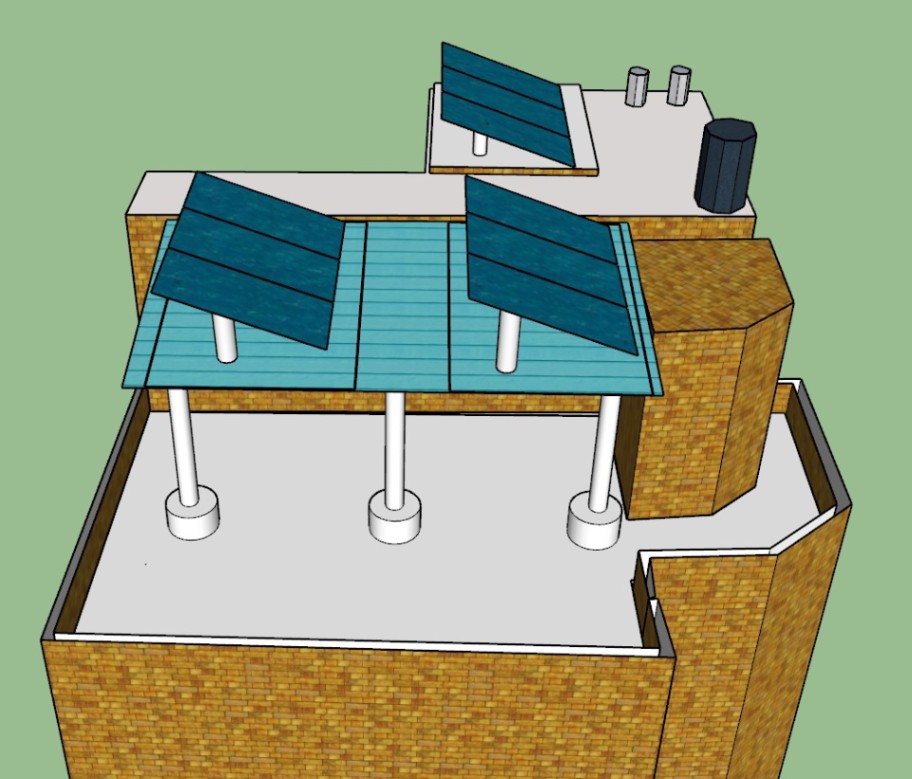3D Solar Modelling Of Rooftop Before Solar Panel Installation

A lot of people who want to install rooftop solar panels face problems in imagining and visualizing how their rooftop solar will look like after it is installed. Since solar panels usually last for decades and are a capital intensive investment, lack of understanding about the end product makes it difficult for interested people to make confident decisions about installing a rooftop solar power system.
Usually, the process of getting a rooftop solar installed looks something like this. The user does some research about the benefits of going solar, solar installers nearby, etc. He then starts communicating his needs with different solar installers. These installers then visit the site and prepare a sketch or blueprint on paper. They also provide a quotation to the interested customer based on the blueprint. Now although the user knows well the benefits of solar power, how it works, and other relevant information, they might still lack clarity on aspects like visualization, aesthetics, power generation, and potential power loss because of shading.
Simply put, the users face three problems -
- They can’t visualize what the solar power system would turn out to be since it is difficult to imagine what is on paper in three dimensions.
- They have no quantitative understanding of the actual power generation, loss, and the impact of factors like shading, roof orientation, and panel angle.
- They have no way of verifying if the design proposed by an installer is optimum and the price quoted is reasonable.
To make the process easier to understand for the user and attain optimum efficiency, 3D Solar modeling, simulation, and pre-installation assessment reports are now being used before carrying out the actual installation. These 3D models are made by using the latest software and can be optimized and tweaked until a configuration most suitable for a user’s need is achieved. Read on to know about-
What is Solar 3D Modeling?

Contrary to a paper blueprint of the rooftop solar system designed by solar installers, a 3D solar model uses pictures and videos to show the arrangement and orientation of how the solar panels and other equipment will be installed on the user’s terrace. This results in the user getting a complete idea of how their solar power system will look like after the installation. The user can then make better decisions and avoid last-minute changes and post-installation glitches. 3D solar modeling takes into account not just the details of the concerned rooftop, but also the surrounding factors like nearby buildings, trees, etc. Since shading of panels can negatively impact the total power output of solar panels drastically, a 3D model and simulation of working of the panels ensure that the effect of shading is eliminated or minimized through strategic placement and orientation of panels.
How Is Solar 3D Modelling Done

(A pre-installation simulation report)
Solar modeling involves the use of satellite imaging and dedicated modeling software to create a three-dimensional blueprint that suits the needs of the users and is designed taking into consideration specific details like latitude of the place, roof orientation, rooftop area available, etc to maximize power output without compromising on the aesthetic appeal of the setup.
After a model is created, the user gets a video that shows a 3D animation of the rooftop with the entire solar structure put in place. The user also receives a report that gives them detailed information about expected power output during different times of the day and times of the year. It also lists down the factors that may lead to a reduction in the power output and their percentage contribution.
For example, if there is a tall building adjacent to the roof on which the panels are to be installed, 3D modeling and simulation will calculate the extent of shading and the percentage reduction in the power generation of the panels because of that. The software also enables the designer to check different orientations and choose the one that best fits the rooftop.
Benefits of 3D Modeling

(Shading analysis of roof)
One of the main reasons people don’t opt for new and better technology is unfamiliarity with how it works and its working procedure. Thus, one of the main objectives of our team at Unergia is to make things easy, hassle-free, and intuitive for the user. 3D Solar Modeling is one of our unique offerings to our users to make their switch to solar power more informed and the best part about it is Unergia does this entire process for FREE!!!!
Few exclusive benefits of 3D solar modeling and simulation are:
No Site Visit Required: Unlike the status quo where installers have to physically visit the prospective installation site to make a blueprint and provide the user with a price quote, 3D modeling can be done remotely with the use of high-resolution satellite images. It is a zero physical contact process and thus quite useful in the present post-covid world.
Saves Time: The user doesn’t have to talk to multiple installers and get multiple designs made and compare price quotes. Unergia makes a 3D model which is then shared with different installers who then bid among each other to provide the best services to the user at the lowest possible price.
Better Efficiency: Since the 3D model is optimized after accounting for several factors, the solar power system works at improved efficiency. Pre-installation designing ensures that there are no last-minute changes and post-installation caveats.
No Expectation-Reality Mismatch: 3D modeling and associated reports simulate the working process of the solar power system and thus the user knows what to expect from their rooftop solar even before it is installed. This means the user has realistic expectations and the process is transparent.
Shading Analysis: Satellite imaging takes into account the structures present on the site as well nearby. The pre-installation report then uses that to calculate the impact of shading on the power generation capacity of the solar panels. The designers can also suggest the use of an elevated mounting structure for the panels to minimize shading losses based on the 3D model.
In life, we would probably make the best choices if only we foresee the results. Although life doesn’t let us do that, solar modeling, simulation, and pre-installation reports can help us understand how our rooftop solar will look a few months down the line and we can be sure of the decisions we make and have no regrets!
 Unergia
Unergia